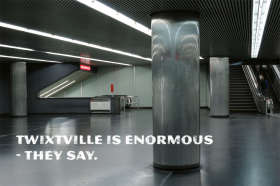Kopfstand09: TwixtVille – A City Planned but Never Built

At the latest Kopfstand09 held on November 17, 2008, Time’s Up and Linz09 elaborated on why Time’s Up’s TwixtVille project—despite intense, protracted efforts to bring it to fruition—will not be produced during the Capital of Culture year.
TwixtVille would have been the consistent next step in the work being done by Time’s Up: an interactive, medially-enhanced large-scale installation that combines spaces for living, working and relaxing with on-site recreational opportunities amidst an urban setting. Plus, TwixtVille would have been a marketplace for ideas and a forum for debates, a discussion platform designed to accommodate symposia, workshops, festivals and parties. The aim was to set up and operate over the course of five months an approximately 2,000-m² world that could be interactively experienced by visitors. A fictive narrative about the city itself was to have served as the basis for TwixtVille—for example, a casting call publicized by media outlets would simulate a TV production. The ultimate aim was for TwixtVille to leave behind traces in “the real world.”Work on this project proceeded for 30 months. This fall, after carefully weighing all options, Time’s Up and Linz09 decided to terminate TwixtVille once and for all. The grounds: despite extremely intensive efforts, it proved impossible to find, somewhere in the economically dynamic City of Linz, vacant industrial premises that would be suitable as a location. More than 40 sites were inspected. A few possibilities that seemed promising vanished on short notice. The upshot was a time problem. On the basis of the then-current state of the project and the results of the work and research that had already been done, thought was given to alternative productions under the working title “PIER 27.” Nevertheless, in light of the costs that the project’s architectural infrastructure would have entailed even if it would be operated for a shorter time, such considerations likewise yielded no alternatives in which outlays stood in a satisfactory relationship to what was to be gained.
Both project partners very much regret this situation. A film documents the solemn burial at sea in which Time’s Up carried the project to what is in the truest sense of the word its grave. Linz09 Artistic Director Martin Heller was enthused by the basic idea of TwixtVille from the very outset and had complete confidence in Time’s Up. TwixtVille was to have mirrored realities, but it was reality itself that ultimately spelled this project’s doom. What remains is a wealth of experience, developed interfaces, objects and an extensive network—and thus a great starting point for Time’s Up to continue developing the content that has emerged to date in new experimental situations.





